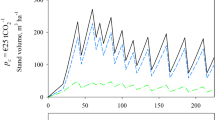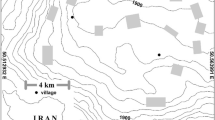Abstract
Planting density is a primary consideration in silviculture; however, planting arrangement is often ignored. Most, if not all, forest plantations are arranged in rectangular or square lattices (i.e., grids). Using a simple mathematical model, we investigate the potential influence of planting arrangement on planting density, biomass yield, and rotation period by assuming that efficiently arranging trees is similar to packing congruent circles on a plane. The hexagonal lattice achieves the densest circle packing on a plane; therefore, a hexagonal or triangular lattice arrangement of stems provides the highest planting density for a given spacing. Using packing density to quantify arrangement efficiency, tree crowns in a hexagonal lattice fill approximately 90.7% of available area at initial canopy contact, while tree crowns in a square lattice fill approximately 78.5% of available area at initial canopy contact. The hexagonal lattice permits about a 15% higher density than the square lattice, which allows canopy closure to occur earlier without any change in individual tree growth. Short rotation woody crop (SRWC) systems are excellent candidates under the model’s assumptions of level stand with even-age monoculture. If belowground resources are non-limiting, a hexagonal lattice arrangement shortens rotation period and thus optimizes the biomass yield per land area over time. Higher productivity over time is central to sustainable and efficient use of limited area for bioenergy and biomass products.






Similar content being viewed by others
References
Coyle DR, Aubrey DP, Siry JP, Volfovicz-Leon RR, Coleman MD (2013) Optimal nitrogen application rates for three intensively-managed hardwood tree species in the southeastern USA. For Ecol Manag 303:131–142. https://doi.org/10.1016/j.foreco.2013.04.016
Aubrey DP, Coyle DR, Coleman MD (2011) Functional groups show distinct differences in nitrogen cycling during early stand development: implications for forest management. Plant Soil 351(1–2):219–236. https://doi.org/10.1007/s11104-011-0946-0
Coyle DR, Aubrey DP, Coleman MD (2016) Growth responses of narrow or broad site adapted tree species to a range of resource availability treatments after a full harvest rotation. For Ecol Manag 362:107–119. https://doi.org/10.1016/j.foreco.2015.11.047
Gallagher T, Shaffer B, Rummer B (2006) An economic analysis of hardwood fiber production on dryland irrigated sites in the US Southeast. Biomass Bioenergy 30(8):794–802
Allen CB, Will RE, McGarvey RC, Coyle DR, Coleman MD (2005) Radiation-use efficiency and gas exchange responses to water and nutrient availability in irrigated and fertilized stands of sweetgum and sycamore. Tree Physiol 25(2):191–200. https://doi.org/10.1093/treephys/25.2.191
Akers MK, Kane M, Zhao D, Teskey RO, Daniels RF (2013) Effects of planting density and cultural intensity on stand and crown attributes of mid-rotation loblolly pine plantations. For Ecol Manag 310:468–475. https://doi.org/10.1016/j.foreco.2013.07.062
Avery TE, Burkhart HE (2015) Forest measurements. Waveland Press, Long Grove
Bickford CA (1957) Stocking, normality, and measurement of stand density. J For 55(2):99–104
Clark A III, Saucier JR (1989) Influence of initial planting density, geographic location, and species on juvenile wood formation in southern pine. For Prod J 39(7/8):42–48
Taylor RG, Fortson JC (1991) Optimum plantation planting density and rotation age based on financial risk and return. For Sci 37(3):886–902
Britt JR, Reynolds JP (2013) Volume and crown characteristics of juvenile loblolly pine grown at various ratios of between and within row spacings. Paper presented at the Proceedings of the 15th biennial southern silvicultural research conference, Asheville, NC
Sharma M, Burkhart HE, Amateis RL (2002) Spacing rectangularity effect on the growth of loblolly pine plantations. Can J For Res 32(8):1451–1459. https://doi.org/10.1139/x02-079
Alexander RR (1971) Crown competition factor (CCF) for Engelmann spruce in the central Rocky Mountains, vol. 188. Forest Service, US Dept. of Agriculture. Rocky Mountain Forest and Range Experiment Station, Fort Collins
Fejes Tóth L (1942) Über die dichteste Kugellagerung. Math Z 48(1):676–684. https://doi.org/10.1007/bf01180035
Chang H-C, Wang L-C (2010) A simple proof of Thue’s theorem on circle packing. ArXiv e-prints 1009
Conway JH, Sloane NJA (1995) What are all the best sphere packings in low dimensions? Discrete Comput Geom 13(3–4):383–403. https://doi.org/10.1007/bf02574051
Fukshansky L (2009) Revisiting the hexagonal lattice: on optimal lattice circle packing. ArXiv e-prints 0911
Department of Energy (2016) 2016 billion-ton report: advancing domestic resources for a thriving bioeconomy. Oak Ridge National Laboratory, Oak Ridge, TN
Berndes G, Ahlgren S, Börjesson P, Cowie AL (2013) Bioenergy and land use change-state of the art. Wiley Interdisciplinary Reviews. Energy and Environment 2(3):282–303. https://doi.org/10.1002/wene.41
Shortall OK (2013) “Marginal land” for energy crops: exploring definitions and embedded assumptions. Energ Policy 62:19–27. https://doi.org/10.1016/j.enpol.2013.07.048
Spiertz H (2013) Challenges for crop production research in improving land use, productivity and sustainability. Sustainability 5(4):1632–1644. https://doi.org/10.3390/su5041632
Valentine J, Clifton-Brown J, Hastings A, Robson P, Allison G, Smith P (2012) Food vs. fuel: the use of land for lignocellulosic ‘next generation’ energy crops that minimize competition with primary food production. GCB Bioenergy 4(1):1–19. https://doi.org/10.1111/j.1757-1707.2011.01111.x
Ibell PT, Xu Z, Blumfield TJ (2010) Effects of weed control and fertilization on soil carbon and nutrient pools in an exotic pine plantation of subtropical Australia. J Soils Sediments 10(6):1027–1038. https://doi.org/10.1007/s11368-010-0222-6
Jokela EJ, Martin TA, Vogel JG (2010) Twenty-five years of intensive forest management with southern pines: important lessons learned. J For 108(7):338–347
Dickmann D (2006) Silviculture and biology of short-rotation woody crops in temperate regions: then and now. Biomass Bioenergy 30(8–9):696–705. https://doi.org/10.1016/j.biombioe.2005.02.008
Amateis RL, Burkhart HE (2012) Rotation-age results from a loblolly pine spacing trial. South J Appl For 36(1):11–18. https://doi.org/10.5849/sjaf.10-038
Amateis RL, Radtke PJ, Hansen GD (2004) The effect of spacing rectangularity on stem quality in loblolly pine plantations. Can J For Res 34(2):498–501. https://doi.org/10.1139/x03-210
VanderSchaaf CL, South DB (2004) Rectangular spacing: an economic benefit? Gen Tech Rep SRS 71. US Department of Agriculture, Forest Service, Southern Research Station, Asheville, NC, pp 437–440
Acknowledgements
We thank fellow researchers M.J. Dix and T. Lee for helpful comments on this manuscript. SWO was supported by University of Georgia Warnell School of Forestry and Savannah River Ecology Lab. DPA was supported by Agriculture and Food Research Initiative Competitive Grant no. 2013-67009-21405 from the USDA National Institute of Food and Agriculture during preparation of this manuscript. This material is based upon work supported by the Department of Energy under Award Number DE-EM0004391 to the University of Georgia Research Foundation.
Author information
Authors and Affiliations
Corresponding author
Electronic supplementary material
ESM 1
Stems (points) arranged in a square lattice spaced x by x (GIF 5 kb)
ESM 2
Stems (points) arranged in a rectangular lattice spaced x by y (GIF 4 kb)
ESM 3
Stems (points) arranged in a triangular lattice spaced by L with projected crowns forming a hexagonal lattice (GIF 18 kb).
Rights and permissions
About this article
Cite this article
Oswald, S.W., Aubrey, D.P. Increasing Biomass Production on Limited Land Area Through an Optimal Planting Arrangement. Bioenerg. Res. 11, 13–21 (2018). https://doi.org/10.1007/s12155-017-9873-0
Published:
Issue Date:
DOI: https://doi.org/10.1007/s12155-017-9873-0




